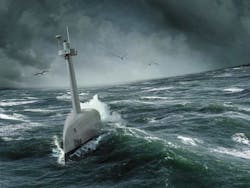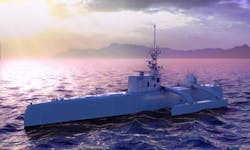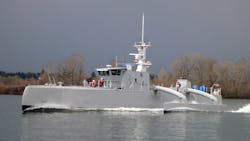Navy picks 40 to develop unmanned surface vessels (USVs), sensor-processing payloads, vehicle autonomy
WASHINGTON – U.S. Navy unmanned vehicles experts are assembling a 40-member industry team, which is a veritable who's who of prime systems integrators and subsystems designers, to participate in a major effort to design next-generation unmanned surface vessels (USVs).
Officials of the Naval Sea Systems Command in Washington announced Wednesday that these 40 companies will share contracts with a potential cumulative value of $982.1 million to support the Unmanned Surface Vehicle Family of Systems. These contracts are for five years, and includes three one-year options.
These companies each will receive $1,000 up-front, and over the next five to eight years will compete for individual delivery orders for integrated unmanned surface vessels, USV propulsion systems, sensor and sensor-processing payloads, and other aspects of advanced USV design.
The project's contractors will provide products and services within six areas: payloads; non-payload sensors; mission-support systems; vehicle autonomy and vehicle-control systems; ashore and host platform elements; and logistics and sustainment.
The 40 companies selected to participate in the Unmanned Surface Vehicle Family of Systems project are:
-- Advanced Acoustic Concepts LLC in Hauppauge, N.Y.;
-- Raven Aerostar Technical Solutions Inc. in Arlington, Va.
-- Arete Associates in Tucson, Ariz.;
-- Austal USA LLC in Mobile, Ala.;
-- Azimuth Inc. in Morgantown, W.Va.;
-- BAE Systems Electronic Systems in Nashua, N.H.;
-- BMT Designers & Planners Inc. in Alexandria, Va.;
-- Continental Tide Defense Systems Inc. in Reading, Pa.;
-- The Charles Stark Draper Laboratory Inc. in Cambridge, Mass.;
-- General Dynamics Mission Systems Inc. in Fairfax, Va.;
-- Gibbs & Cox, Inc. in Arlington, Va.;
-- Gravois Aluminum Boats LLC, doing business as Metal Shark, in Jeanerette, La.;
-- Huntington Ingalls Industries Fleet Support Group LLC in Virginia Beach, Va.;
-- Hydroid Inc. in Pocasset, Mass.;
-- ICI Services Corp. in Virginia Beach, Va.;
-- L3Harris Unidyne Inc. in Norfolk, Va.;
-- Leidos Inc. in Reston, Va.;
-- Lockheed Martin Rotary and Mission Systems in Moorestown, N.J.;
-- Maritime Applied Physics Corp. in Baltimore;
-- Micro Systems Inc. subsidiary Kratos-MSI in Fort Walton Beach, Fla.;
-- Northrop Grumman Corp. Autonomous Systems in Bethpage, N.Y.;
-- Paste link hereOasis Systems LLC in Rockville, Md.;
-- Oceaneering International Inc. in Hanover, Md.;
-- Peraton Inc. in Herndon, Va.;
-- Q.E.D. Systems Inc. in Virginia Beach, Va.;
-- Raytheon Integrated Defense Systems in Portsmouth, R.I.;
-- Reliable Systems Services Corp. in Melbourne, Fla.;
-- Rolls-Royce Marine North America Inc. in Walpole, Mass.;
-- Science Applications International Corp. (SAIC) in Reston, Va.;
-- System Engineering Associates (SEA) Corp. in Middletown, R.I.;
-- Sedna Digital Solutions LLC in Manassas, Va.;
-- Serco Inc. in New London, Conn.;
-- Spatial Integrated Systems Inc. in Virginia Beach, Va.;
-- Teledyne Brown Engineering Inc. in Huntsville, Ala.;
-- Textron Systems in Hunt Valley, Md.;
-- The Boeing Co. Defense, Space & Security segment in St. Louis;
-- The Columbia Group Inc. in Washington;
-- Paste link hereTridentis LLC in Alexandria, Va.;
-- Ultra Electronics Ocean Systems (UEOS) in Braintree, Mass.; and
-- W R Systems Ltd. in Norfolk, Va.
Related: Raytheon, Applied Physical Sciences to develop Navy unmanned mine-hunting technology
Example payloads are towed sonars, data recorders, payload controllers, and signal processors, and may include optical, acoustic, infrared, radar, radio, underwater electromagnetic, deployed systems, towed systems, and homing & docking interfaces.
Towed sonars will have an actively controlled towed body with automatic depth or altitude control based on the mission and will detect, classify, and locate bottom, close-tethered, and volume mines in one pass.
Acoustic sensors will include side-looking sonars with synthetic aperture sonar (SAS), volume search sonar, and an optical identification sensor to identify bottom mines.
Related: Navy to develop unmanned surface vessels as its newest generation of minesweepers
Contractors will conduct payload research, handle cyber security and trusted computing, and provide build-to-print technical data packages for follow-on competition, production, modification, integration, and test.
Non-payload sensors are necessary for basic operation of the USV, and may include forward-look sonar, transducers, hydrophones, automatic identification systems, imaging, radar, transponders, conductivity, temperature and depth, sub-bottom profiler, Doppler velocity log, Global Positioning System (GPS), and altimeters.
Autonomy and vehicle control systems enable the USV to develop and select among different courses of action based on the USV’s knowledge and understanding of the situation. These systems will enable the USV to monitor and conduct the mission.
Ashore and host platform elements are the systems and subsystems that enable a USV to interface, launch, and recover from an ashore and or host platform, and may include launch and recovery hardware, data interface systems, hardware interface systems, electrical interface systems, local command and control, energy system charging and refueling equipment, onboard storage equipment, maintenance equipment, and tendering for a USV.
Elements include USV communications between the USV and its ashore host, USV to USV, and USV to its payloads, such as radios, cross-domain solutions, enclosures, power supplies, and communications software.
Logistics and sustainment activities are services necessary to maintain optimal performance of the USVs, payloads, and related components throughout the program life cycle.
On these contracts the Unmanned Surface Vehicle Family of Systems companies will do the work in various locations of the contiguous U.S., and should be finished by February 2025. With options, work could continue until February 2030.
For more information contact Naval Sea Systems Command online at www.navsea.navy.mil.
About the Author
John Keller
Editor-in-Chief
John Keller is the Editor-in-Chief, Military & Aerospace Electronics Magazine--provides extensive coverage and analysis of enabling electronics and optoelectronic technologies in military, space and commercial aviation applications. John has been a member of the Military & Aerospace Electronics staff since 1989 and chief editor since 1995.



